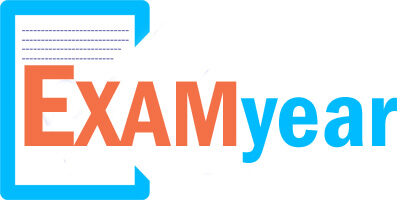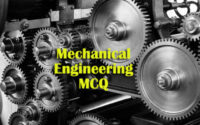Practice Set on Diploma Mechanical Engineering
Interested users can download the Practice Set on Diploma Mechanical Engineering from the links enclosed below. Download the Last 5 Years Practice Set on Diploma Mechanical Engineering Solved along with the Answers of each question.

This Practice Set on Diploma Mechanical Engineering may vary from the Actual paper. Use the Practice Set on Diploma Mechanical Engineering as a reference for the exam preparation. Check the Practice Set on Diploma Mechanical Engineering from this page.
At the bottom of this page, you will find ‘Click here links’ for downloading the Practice Set on Diploma Mechanical Engineering. Click on the required link & download your related Practice Set on Diploma Mechanical Engineering to make as a reference for your scheduled preparation.
Diploma Mechanical Engineering Practice Set Paper
1. Which one of the following micro constituents has maximum hardness?
(a) Austenite
(b) Pearlite
(c) Sorbite
(d) Cementite
2. When _______ is added to, its tensile strength of steel can be increased by adding
(a) Chromium
(b) Manganese
(c) Magnesium
(d) Tungsten
3. Which one of the following is an alloy of copper and zinc?
(a) Brass
(b) Bronze
(c) Duralumin
(d) None of these
4. Examples of line defects are
(a) Vacancies
(b) Dislocations
(c) Twins
(d) Stacking faults
5. Which of the following elements does not impart hardness to steel?
(a) Copper
(b) Chromium
(c) Nickel
(d) silicon
6. Carbon steel is
(a) made by adding carbon in steel
(b) refined from cast iron
(c) an alloy of iron and carbon with variable quantities of phosphorus and sulphur
(d) extremely brittle
7. Which of the following is the most ductile material?
(a) mild steel
(b) copper
(c) zinc
(d) aluminium
8. Delta iron occurs at temperature of
(a) room temperature
(b) above melting point
(c) between 14000C and 15390C
(d) between 9100C and 14000C
9. Type of alloyed plain carbon steel used for drawing dies, punches and drills is
(a) high carbon steel
(b) medium carbon steel
(c) high speed steel
(d) none of these
10. Which one of the following is the cause of tool failure?
(a) excessive temperature
(b) excessive stress
(c) flank wear
(d) all of these
11. The angle obtained between the machined surface and underside of the tool is generally named as
(a) clearance angle
(b) relief angle
(c) edge angle
(d) nose angle
12. The tool life under oblique cutting in comparison to that of orthogonal cutting is
(a) Same
(b) Less
(c) More
(d) none of these
13. In which of the following welding processes is non-consumable electrode used?
(a) TIG welding
(b) LASER welding
(c) MIG welding
(d) plasma arc welding
14. In which of the following processes does electrode get consumed?
(a) TIG welding
(b) resistance welding
(c) thermit welding
(d) arc welding
15. Time required for non conventional machining in comparison to the conventional machining is
(a) Less
(b) Equal
(c) More
(d) unpredictable
16. Automobile bodies can be manufactured by employing
(a) deep drawing
(b) tube drawing
(c) wire drawing
(d) rod drawing
17. The heating of pressed compact to below the melting temperature of any constituent of the product, or at least below the melting temperature of all principal constituents of the product is called
(a) Tempering
(b) Compacting
(c) Atomizing
(d) sintering
18. The material used for coating the electrode is called
(a) Flux
(b) Slag
(c) protective layer
(d) deoxidizer
19. A forming operation which is carried on cylindrical rolls is termed as
(a) Casting
(b) Drawing
(c) Rolling
(d) grinding
20. A model of casting which is constructed in such a way that it can be used for forming an impression in damp sand is defined as
(a) Molding
(b) Pattern
(c) damper
(d) prototype
21. In sand casting, draft allowance is added to
(a) All linear dimensions
(b) Only the interior dimensions
(c) Only the exterior dimensions
(d) Only to the dimensions that are perpendicular to the parting plane
22. Hot-chamber die-casting process is used for
(a) Aluminium
(b) Zinc
(c) Cast iron
(d) Steel
23. Drawing out is a forging operation used to
(a) reduce the cross section of a part
(b) increase the cross section of a part
(c) finish the part
(d) flatten the part
24. Filler metal is not required in the following type of welding process:
(a) Oxy-oxy-acetylene welding
(b) Arc welding
(c) Resistance welding
(d) Oxy-oxy- hydrogen welding
25. Consumable electrode for manual metal arc welding of steel is made of
(a) tungsten
(b) steel
(c) copper
(d) cadmium copper
More Question Set on Mechanical Engineering Diploma MCQs from Various Exam
| Model Question | Old Question |
| Sample Papers | Mock Test |
| Practice Set | Question Bank |
| Important Questions | Test Papers |
| Typical Questions | Selected Questions |
26. For gas welding of brasses, the most useful flame is:
(a) oxidizing flame
(b) reducing flame
(c) neutral flame
(d) no specific choice
27. Which of the following conditions does not favour the production of discontinuous chips?
(a) brittle material
(b) large chip thickness
(c) low cutting speed
(d) large rake angle
28. In grinding wheel a dense structure is required for:
(a) tough material
(b) ductile material
(c) heavy cuts
(d) finishing cut
29. The flexible manufacturing systems (FMS) is most suitable for a production system that falls under
(a) mass type
(b) batch type
(c) job type
(d) all of these
30. Margin of safety is generally expressed as
(a) ratio of budgeted sales to sales at BEP
(b) ratio of actual sales to sales at BEP
(c) percentage of budget to BEP
(d) all of these
31. The prime objective of value engineering is to minimize
(a) cost of production
(b) time of production
(c) cost of labor
(d) cost of value
32. In process chart, the symbol stands for the meaning of
(a) storage
(b) inspection
(c) delay
(d) transport
33. PERT is a network analysis mainly based on
(a) event oriented
(b) activity oriented
(c) process oriented
(d) none of these
34. The size of order which minimizes total cost of carrying and cost of ordering is called
(a) minimum order quantity
(b) economic order quantity
(c) safety order quantity
(d) re-order quantity
35. Which one of the following is not an attribute of the control chart?
(a) P chart
(b) R chart
(c) C chart
(d) np chart
36. The total cost of manufacturing a product is reduced due to
(a) standardization
(b) diversification
(c) simplification
(d) sophistication
37. Work study is concerned with
(a) improving present method and finding standard time
(b) motivation of workers
(c) improving production capability
(d) all of these
38. Scheduling gives information about
(a) when work should start and how much work should be completed in a certain period
(b) when work should completed
(c) how idle-time can be minimized
(d) proper utilization of machines
39. Product layout is employed for
(a) batch production
(b) continuous production
(c) effective utilization of machine
(d) none of these
40. Statistical quality control techniques are based on the theory of
(a) quality
(b) statistics
(c) probability
(d) all of these
41. An optimum project schedule implies
(a) optimum utilization of men, machines and materials
(b) lowest possible cost and shortest possible time for project
(c) timely execution of project
(d) to produce best results
42. Graphical method, simplex method and transposition method are concerned with
(a) break-even analysis
(b) value analysis
(c) linear programming
(d) inventory control
43. PERT has the following time estimate
(a) one time estimate
(b) two time estimate
(c) three time estimate
(d) four time estimate
44. Bar charts are suitable for
(a) minor works
(b) major works
(c) large projects
(d) all of these
45. A flow diagram drawn to scale must be given with
(a) outline process charts
(b) flow process charts
(c) multiple activity chart
(d) SIMO chart
46. The number of fundamental hand motion in micro-motion study are
(a) Thirteen
(b) Fifteen
(c) sixteen
(d) nineteen
47. Which one of the following is not a queing theory model?
(a) orders waiting to be processed
(b) machines waiting to be repaired
(c) machines in an assembly line to be operated
(d) batch of finished products waiting to be transported
48. The probability distribution of project completion time in PERT is
(a) Gaussian
(b) Gamma
(c) Beta
(d) binomial
49. Stoichiometric air–fuel ratio of petrol is roughly
(a) 50 : 1
(b) 25 : 1
(c) 15 : 1
(d) 1 : 1
50. In a two-stroke engine, one power stroke is obtained in
(a) one revolution of the crank shaft
(b) two revolutions of the crank shaft
(c) four revolutions of the crank shaft
(d) none of these

